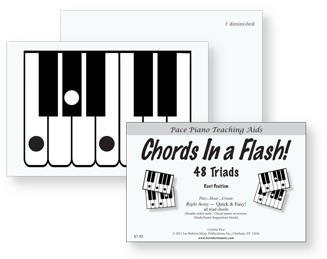also see "Chord Go-Fish"
1. Exploring the Sounds: Student randomly selects several chord cards, then plays and listens to each. (Student may play chords, one note at a time and/or three notes all together, using one or both hands to begin with). Student describes “feeling” that each different chord sound seems to express. Students in a class may take turns randomly choosing and then playing cards for others. Others respond by describing chord “feeling,” or by drawing facial expressions that match their perception of chord sound. Students become attuned to wide harmonic variety, attending fully to the sound, first, then soon after attaching a symbol or name.
2. Chord Recognition (**See “Flashcard Go
Fish” Game): Teacher sorts the twelve major chords into
their “color groups:” Set 1) all white keys—C, F, and G major chords; Set 2)
black middle key—A, D, and E major; Set 3) black keys on outside—Ab, Db, and
Eb; Set 4) “Odd” chords—Gb, Bb, and B major.
•Student looks at cards chosen from
one chord-set at a time, and practices naming chords (answer on card’s
reverse).
•Student chooses a card from a set and plays in all places on the
keyboard.
•Alternatively, student identifies the names of the notes in chord,
and notates chords.
Student randomly selects several chord cards, then plays and
listens to each. (Student may play chords, one note at a time and/or three
notes all together, using one or both hands to begin with).
•Student names
“feeling” that each different chord sound seems to express.
•Students in a class
may take turns randomly choosing and then playing cards for others. •Others
respond by describing chord “feeling,” or by drawing face showing expressions
that match their perception of chord sound.
•Students become attuned to wide
harmonic variety, attending fully to the sound, first, then soon after
attaching a symbol or name.
3. Improvisation/Composition: Student picks several
chords randomly from entire deck, or from a set pre-selected by teacher.
(Examples: all C chords (augmented, major, minor, diminished), or any augmented
chord, or only chords with a black key in the middle, or only C, F, and G
minor), or a G, C, D [I-IV-V] chord progression, etc.).
•Student(s) improvises
with chords. Examples: student plays each individual note of a chord in
different orders and rhythms.
•Other times student plays all three notes
together, divided between hands, in one hand, or as a chord in each hand.
•Later, student a) plays chords from several cards in succession, b) plays
different chords together simultaneously (for bi-chordal sound).
•Students can
create “sound stories” by playing these various chords in various ways and
registers on the piano, with or without pedal, to tell the story.
4. Ear Training: Teacher selects a set of cards (appropriate to student’s level) that contain chords sharing the same keynote name (e.g. C major and C minor; or F# augmented, F# major, F# minor, and F# diminished, etc). Teacher or student chooses a card without showing it and plays the chord. Another student listens and tries to play back the same chord. Alternately, after hearing chord, student tries to correctly name the chord, or to correctly notate it.
